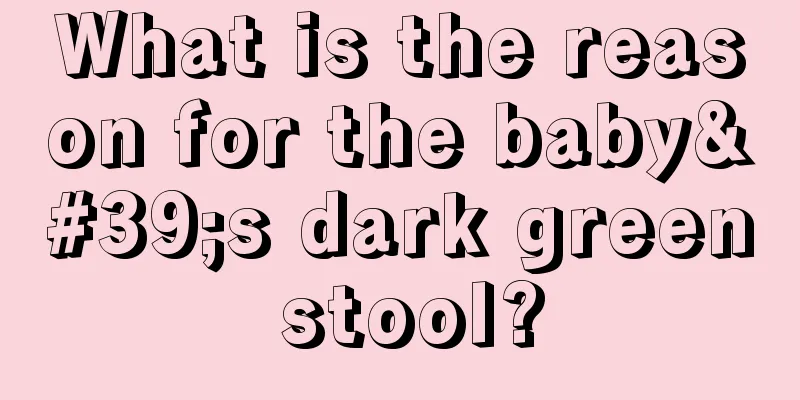What diseases should be differentiated from when a 3-year-old child coughs without sputum?

|
Cough is a complex disease. Newborns will also cough after being infected with viruses, and adults or the elderly will also have various types of coughs. Taking children as an example, coughing is called pediatric cough. The types of coughs can be divided into dry coughs, phlegm coughs, etc. The type can only be determined after diagnosis. A 3-year-old child's cough without phlegm can also be divided into coughs after a cold, and some are pharyngitis, etc. So what diseases should be differentiated from a 3-year-old child's cough without phlegm? Clinically, most chronic dry coughs are allergic coughs, also known as cough variant asthma or allergic bronchitis. The causes of allergic cough are complex, but mainly include two aspects, namely the constitution of patients with allergic cough and environmental factors. The patient's physical constitution, including subjective conditions such as "genetic quality", immune status, mental and psychological state, endocrine and health status, is an important factor in the patient's susceptibility to allergic cough. Environmental factors including various allergens, irritating gases, viral infections, residential areas, living conditions, occupational factors, climate, medications, exercise (hyperventilation), food and food additives, eating habits, social factors and even economic conditions may be more important causes of the occurrence and development of allergic cough. The increasing trend in the incidence of allergic cough is also related to the susceptibility caused by the patient's allergic constitution and environmental factors. Laboratory tests must be summarized and analyzed based on the objective data obtained from medical history and physical examination, from which several possible diagnoses can be proposed, and then further consideration should be given to which actual laboratory tests should be performed to confirm the diagnosis. Therefore, in view of the dry cough and its associated symptoms, corresponding laboratory tests can be performed, such as blood routine, lung X-ray, laryngoscopy, etc. Identification: 1. Pharyngitis Chronic pharyngitis is a common pharyngeal disease, the most prominent symptom of which is an irritating dry cough. Patients experience itching and discomfort in the throat, and often have dry coughs to clear the throat. The symptoms are more obvious when speaking, and can be relieved after drinking water or swallowing. Most of them are secondary to infectious lesions of the upper respiratory tract, or are more common in frequent smokers, alcoholics, and those who engage in certain activities that expose them to harmful dust or gases. Examination of the pharynx may reveal congestion of the pharynx. Many dilated capillaries and a small number of proliferating lymph follicles may be seen on the surface of the posterior pharyngeal mucosa. This is more common in the posterior pharyngeal mucosa and in people who are exposed to certain harmful dusts or gases. 2. Laryngitis The main symptom is hoarseness, which often occurs intermittently in the early stages and occurs when there are more pronunciations. If the disease worsens, the hoarseness may become persistent, but it is rare for a person to not suffer from aphonia. The patient has a dry cough to relieve symptoms. Laryngeal mucoscopy examination shows that patients with chronic simple laryngitis often show congestion of the laryngeal mucosa, loss of luster of the vocal cords, dilated blood vessels distributed on them, and increased mucus secretions; when the condition worsens and develops into chronic proliferative laryngitis, the mucosa is significantly thickened and dark red, with thickened and rounded edges, and it is often incompletely closed during pronunciation, and the laryngeal ventricular zone is often thickened due to compensatory activities; chronic atrophic laryngitis is rare, and yellow-green crusts are often coughed up after coughing, and there is a burning or pain in the throat. What diseases should be differentiated from a 3-year-old child's cough without sputum? Normal coughs are mostly caused by a cold, and the characteristics of a cold are the most obvious among its symptoms. The probability of a child who is too young suffering from pharyngitis or laryngitis is small, but there is a chance of it occurring. When making a judgment, you need to observe the type based on the medical history. If it is just a simple cough without sputum, a lung examination is needed. B-ultrasound can diagnose the disease. Only after the disease is confirmed can the cough be controlled to avoid repeated and more complicated coughs. |
<<: What should a 4-year-old child eat when he has a cough?
>>: How to care for a 3-year-old child with fever and cramps?
Recommend
Symptoms of urethritis in children
Urethritis is no longer just a disease that occur...
What is the standard for baby’s development at four and a half months?
Four months is a critical period for the baby'...
At what age is it better for children to sleep alone?
Generally, babies sleep with their parents. Howev...
Causes of black teeth in children
Everyone knows that teeth are very important to u...
What are the emergency measures for a heart attack?
Heart disease is a very serious type of disease, ...
Baby cold virus bacterial treatment
We all know that babies have small bodies, so the...
How to treat scarlet fever in children
Once a child develops scarlet fever, the symptoms...
Why does my child have a low fever in the afternoon?
Some people will choose a fever stage when they h...
What to do if your child's throat is red and swollen
Usually, the reason why children have red and swo...
How to supplement calcium for infants with laryngeal stridor
We all know that the reason why babies suffer fro...
How many months at most will a baby walk?
The arrival of a child is something every couple ...
How to treat a child with a high fever of 40 degrees?
Some children have weak constitutions and need ca...
How many months does the baby start to grab things?
The healthy development of the baby after birth i...
What happens if a child has a fever but only his head is hot?
Children's physical development is immature c...
What should I do if my 4-month-old baby has a fever and diarrhea?
A four-month-old baby is very sensitive to everyt...









